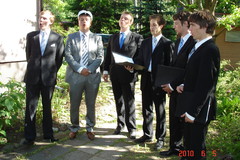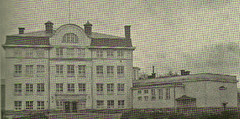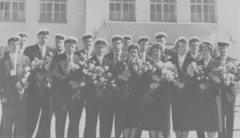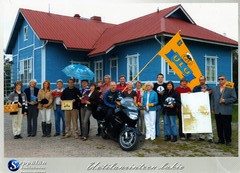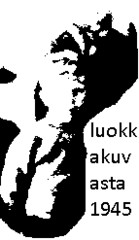Lukiokynnys?
A KIND OF UNGRADEDSunnuntai 10.3.2013 klo 15.55 - ANSSI KUUSELA GYMNASIUM, SECONDARY SCHOOLING, VOCATIONAL SCHOOLING, GENERAL SCHOOLING, FINNISH SECONDARY SCHOOLING, GRADED SCHOOL SYSTEM, UNGRADED SCHOOL SYSTEM, FINNISH UNGRADED LUKIO, CURRICULUM, MODULAR CURRICULUM, PERIODICAL SCHEDULE, FINNISH LUKIO, FINNISH GRADED AND UNGRADED LUKIO, MODULAR CURRICULUM, PERIODICAL SCHEDULE LUKIO, LUKION HISTORIA, SOSIAALINEN/YKSILÖLLINEN OPPIMINEN/OPISKELU, LUOKATON LUKIO, GYMNASIUM, LUOKATON OPETUSJÄRJESTELMÄ, VUOSILUOKKIIN JAETTU JÄRJESTELMÄ, TOISEN ASTEEN KOULUTUS, YLEISSIVISTÄVÄ/AMMATILLINEN KOULUTUS, MODUULIT, KURSSIMUOTOINEN OPETUSSUUNNITELMA, JAKSOJÄRJESTELMÄ, YLIOPPILASTUTKINTO (The text below is published also in the English Wikipedia.)
A KIND OF UNGRADED The Finnish Version of Ungraded SchoolHistorically the traditional gymnasium in Finland as well as in other European countries was exclusive and segregating, a school for elite and for screening the upper classes. On these premises, apart from its cultural mission, it was only natural that the essential curriculum of gymnasium was theoretical and unpractical, academic and non-utilitarian, far from the lives of common people. Basically the nature of gymnasium stayed that way, though the growing numbers of students, industrialization and for instance the progress of international connections compelled to some changes, e.g. to take up spoken languages, which gradually pushed Latin and Greek more and more towards margin. But it was not until the [[progressive education]] movement started to criticise the narrowness and formalism of traditional education that the question of the need of reforms arose. Until the 1970´s Finland had a very segregating parallel school system: the folks-school and a version of the European gymnasium. Four classes in the Kansakoulu were common to all. The first segregating point was, when some entered gymnasium (if they had passed the entrance examination) and the others continued in the folks-school. The division was fatal, because only those who had passed the five classes of gymnasium were accepted into the three further classes of gymnasium, practically the only gateway to academic studies. This segregation point was abolished, at least in theory, in the 1970´s, when the folks-school and the five lower classes of the gymnasium were united into a comprehensive whole. From that on all who had passed it, were entitled to the finishing classes of gymnasium. The second segregating point was, when, after five gymnasium classes, some continued to the three further gymnasium classes, while some others entered professional schooling or finished school. Those who passed the [[matriculation examination]] at the end of the gymnasium, got an undergraduate certificate that entitled them to academic studies. The emblem of undergraduates was the "white cap", distinguishing its carriers from the others. Originally practically all "white-capped" and until, say, the sixties a great majority of them started at least lower academic studies. But later a growing number of undergraduates have entered professional schooling of a lower status and even vocational schooling for which the matriculation examination is not required. This weakening of the segregating function has been due to natural reasons, mostly to rapidly growing numbers of students in "lukio" and general modernization. There was strong political pressure, even before the beginning of the 20th century, to reform the segregating system. But for many reasons it was not until 1970´s that the compulsory part of it (folks-school and five gymnasium classes) were united into a comprehensive whole. the three finishing gymnasium classes,“lukio”, continued two more decades. It is true that there was a set of changes in 1982 that was called a reform, but ,as we shall see further on, renovations were at that stage only technicalities, and otherwise the old annoyances grew even graver. This essay is an attempt to give an account of the reasons for the tardiness of the reform of the “lukio” and of the path that finally led to a kind of ungradedness that came about in Finland in the 1990´s. The first committee charged with preparing a proposition of a pedagogic reform of the "lukio" (the three finishing grades of the gymnasium) published its work as early as 1933. It concluded that the working schema together with the curriculum of mutually independent subjects was incoherent and disconnected, as the lessons were placed in a haphazard way without any didactic point of view onto a weekly schema, which repeated every week of the school year exactly in the same form. So the system ached for centralization. Looking for a remedy the committee brought up Helen Parkhurst´s idea of ungraded school and her Dalton Plan. But finally the committee thought that ungraded system would be too demanding a change for the then Finnish school system, and did not include it in its proposal. Instead it proposed grouping the subjects and periodizing the groups so that all the subjects would not be on at the same time. When the work was published, the opposition was loud, and for well known reasons the 1930´s was a very unfavorable time for a school reform. But the idea of the periodic system survived to be brought up, when the century turned to its second half. In the end none of the proposals of the committee were realized. At the beginning of the 1950´s there was another official committee with a similar task as that of its predecessor twenty years earlier, but it could not produce anything new, on the contrary it looked backwards trying to revive the Herbartian heritage. Modernization was not yet in the horizon of the committee. Even the "Lukio Committee", which published its work in 1970, when the coming reform of the compulsory stage was already well known, concentrated only on some details, e.g. evaluation and matriculation examination. This was the time, when it would not yet have been too late for a plan of a necessary reform for the secondary schooling after the comprehensive primary stage. The first official preparatory measure was the nomination of a committee in 1971. The parliamentary directive was that the guideline of the reform should be equality and so be comprehensive by nature. As we shall later see, comprehensiveness did not come to pass. Far from the "maddening" centers of power there had - before even the slightest stir in the administration - been a spark which would prove to be the beginning of a path that should lead - after many adversities and reverses - to a reform of the "lukio" (the vocational schooling was at that stage following a separate line of its own). The start of the path was In Sysmä, a small country town in Central Finland. In 1949 the headmaster of the local school Touko Voutilainen took as his task to do something about the imperfection that already the first gymnasium committee had set its eyes on: incoherence and disconnectedness of the system. He acquired an official permit an experiment the goal of which was to gain more centralization. He devised a periodical working order. Instead of the same schedule of lessons for every week of the school-year, the year was divided into periods, each having a special schedule. The subjects were divided into periods according to a kind of on/off-principle: when a subject was ON, the number of lessons was increased, for instance doubled, when OFF, the number of lessons was null. This was how incoherence and disconnectedness of teaching could be lessened. Seen from now, the move does not seem very extraordinary, but at the time it was a breach in a long tradition thought to be little short of eternal. The Sysmä experiment lasted only for one school-year, as its leader moved to Helsinki - to greener pastures. But Voutilainen took the new system with him. Soon the period system was developed further in the Helsinki yhtenäiskoulu and then in The Käpylä Evening Schoo]. The former was founded in 1956 and the latter in 1962 Voutilainen being the main agent in starting them and their self-evident headmaster. In the former the learning material started to take courselike shape and measure so as to be fit to be taught in one period. In the evening school the teaching unit of one lesson per week was replaced by course measuring as many lessons as the number of school weeks. So the curriculum consisted of separate named courses of equal length. Courses could be placed, timed, repeated etc. more freely, and so it was possible to pay attention to pedagogic and didactic needs, goals, demands etc., which was not possible, if the weekly schedule of lessons became fixed for the whole year. In addition to concentration periods and courses produced flexibility. The traditional presupposition has been that school is what it is and where everyone is measured with the same standard. The student has been supposed to adapt to it - or if he is unable or unwilling to do so, he was in a wrong school. It could be – in fact was - said that the school of the same content, duration, methods, criteria etc. for every one fulfills the ideal of equality, and gives every one equal opportunities. So it would, if the students were similar, came from the same kind of background, matured at the same pace, learned in the same manner, their interests were of the same kind etc. But this is not the case. The classroom, in the view of the most influential theorist of progressive education, the American philosopher John Dewey, was to be a democracy in microcosm. And according to democratic ideals people´s different means, needs, situations, ends, interests etc. must be taken into consideration in the distribution of social benefits. In the Käpylä Evening School students were adults, and their studying backgrounds and ends as well as their learning experiences and abilities varied widely as well as their living situations. Not to speak of the numbers of those who gave up, because they concluded that it would be impossible for them to engage themselves to a graded system of three years with fixed permanent groups and schedules. For many of those, who had been able to start, it was too hard to keep pace and finally resigned. The same program at the same collective pace in a fixed group was very unsuitable for students, who differed widely in so many respects from each other - and were essentially in a different situation from that of day-schools into the system of which they were subjected to. The first attempt to approach the problem in Käpylä was an experiment that was called “the Speed Line. It was, on a voluntary basis, a fastened program of two years to do the ordinary 3-year examination. The result being dissatisfying the staff planned another kind of experiment. Now they searched for a possibility of variation to meet the needs of different students in varying situations. Their attention focused on what was the obstacle that kept the student from following an a more flexible route as to the duration, content and level of studies. The answer was: the graded system, in which every student belonged to a fixed group and was bound to advance through the three grades. And, in principle, all the members of a permanent group were obliged to attend the same daily program of lessons collectively through all the three years. Only if the student was disengaged from his or her age-cohort (grade) and freed from belonging to any permanent group, one could make individual choices and have a possibility of optimizing one´s duration and quality of studies. The emancipation from the confinement to predestined cohorts and classes together with '''periodical''' organisation of schoolwork and '''course-structure''' of curriculum was the basis for a new kind of school strategy: ungraded organization of school-work. The student´s non-dependence from a fixed grade and group and consequently from a prearranged schedule was adopted as the basis for the new system. This produced two essential results: First, the student could plan, or at least be the interested party in planning, his/her individual program of studies. Second: He/she was free to regulate the time-dimension of his/her studies. Internationally ´ungraded´ had been chosen for the characteristic label of the new system. Käpylä did not disagree, but they wanted to bring forth and stress what they thought might be even more characteristic of the new system. The staff at Käpylä coined variation with time as the "trademark" for the strategy that had evolved feature by feature during more than twenty years starting from Sysmä and culminating in their Experiment of the Ungraded Lukio. In every phase a step further had been a result of innovative solution of a real problem. That is at least partly why there was genuine freshness and inventiveness in the activity at Käpylä. And most important of all, the innovations had feasibility, because the system was developed in the immediate everyday practice of the schools. When the official Experiment of Ungraded Gymnasium ended in 1972, the result was relatively clear-cut and ready to be used, needing only some smaller further refining, for instance studying rules in a system essentially different from the preceding. Anyway there was an ungraded system to take, for instance to solve the fundamental imperfections in the traditional gymnasium instruction and leveling its undemocratic segregating functions. The Käpylä experiment had proceeded relatively unnoticed and without any wide publicity. At this point you could still say that what had been done had been done for a cause, not for show.So far, so good. But after the success in an evening school, inevitably, there arose the question, if ungraded system would work also in day-schools, where students were younger. Two day-school experiments were started In 1972 to get an answer, one in Mäkelänrinteen yhteiskoulu and the other in Alppilan yhteislyseo. Both adopted the system developed in the Käpylä Evening School. The staff in the former school had been interested in the new strategy and in advance studied the pedagogical philosophy on which it was based. They had even applied some of its features already beforehand. Since the beginning of the experiment Mäkelänrinne has been ungraded and contributed many important additions to the system. It has been and still is one of the leading gymnasiums in Finland. At least some of the credit for this is due to the novel system, which provided scope and organisational possibilities for inventions. The retired headmaster Rainer Pelkonen (see Luokattomuuden tulo Suomeen) is, in addition to Touko Voutilainen, one of the main developers of the Finnish ungraded school. Unfortunately the first experiment year in Alppila was a failure, probably mainly because preparation of the staff had been, if not nonexistent, fatally insufficient regarding the scope of the change. Though the teachers had not had enough opportunity to acquaint themselves with the new system and clearly did not understand how widely it would differ from traditional school, the school gave the students almost complete freedom to choose their programs right in the beginning. The staff was unable to handle the situation, and the consequence was nearly a disaster, a quick "normalization" and the resignation of the headmaster. The school soon informed that there would no more be "any variation of time", that the aim would be three grades in three years and that free choices would be allowed only in marginal subjects. This declaration notwithstanding the experiment continued under the auspices and the name of an "ungraded" system. So it came about that Alppila gave a sign that it would be alright to remain more or less graded under the word of "ungraded". In fact the policy of "three grades in three years" was even more pressing than the traditional graded school, because in a school supposed to be without grades you could not possibly repeat a grade - which was quite a frequent procedure in the traditional gymnasium, when some one was not able to keep pace. (One of the most prominent official goals of the experiment had been the need to get rid of repetitions of the whole curricular content of a grade, because it was, rightly, seen as waste of time for the student and waste of money for society.) But at the same time "elsewhere" the course of events rolled on uncompromisingly. Around the middle of the 1970´s the scene was appropriated by the main stream of the national educational policy. Namely, the reform of the compulsory primary education was under way, and in a couple of years any one who would have passed the comprehensive primary stage would be knocking on the doors of secondary schools, vocational as well as general. This meant that,in principle, almost all Finnish youngsters would be passable into lukio. The awakening of the highest headquarters was late consideing that the situation called for far-reaching decisions about national educational policy for the secondary stage. Having heard the call to arms the government had appointed a large, politically representative committee (The 1971 School Committee) to plan the reform and gave the principles of equality and comprehensiveness as the guiding cornerstones of the new secondary school. The committee followed the instruction and proposed a '''comprehensive secondary school of twelve years''', the 11th and 12th years consisting of 2-year vocational sectors. One of the sectors would have been general, i.e. a 2-year substitute for the three-year lukio. Ungraded system was not included, because the principle of variation of time did not fit the scheme. That was because, according to the interpretation of the committee, equality demanded schooling to be of equal length to all. And of course a three-year lukio could not possibly fit in. The most prominent and immediate reaction to the proposal of the committee was a hectic nationwide debate about the question of the traditional 3-year lukio. The conservatives demanded that it should remain separate, last three years and be allowed to keep its specific position. The "res novae" party were ready to abolish its special position and accept the duration of two years. The conservative line was victorious, when the guidelines for the reform were set by the resolution of the Government in 1974. So the far-reaching decisions were made, besides prematurely, in a state of loud confusion. In this situation the government resorted to pragmatism. The "verdict" was practical and popular enough: the day-lukio was to continue as a separate and graded three-year school - as the majority had wished in a loud voice. Both general and vocational schooling were to be developed as separate, the guideline for the latter was that it should be developed so as to become a competent alternative for "lukio". The disappointment of those who had worked for a non-segregating comprehensive secondary stage was disheartening - but in hindsight the government may have been right, when it concluded that, in the then situation in the 1970´s, the Finnish schooling system would not have been ready for so big a change. But the government and its then minister of education, Ulf Sundquist can be blamed for the hurry and haste, for having miscalculated what was the degree of urgency, importance and timing in the impending agenda. Considering the scope of the maneuver it would not have been too early, if the preparation for the reform of the secondary stage had been embarked upon not much later than the preparation for the reforming project of the primary stage. So the ungraded lukio was dropped altogether by the government´s 1974 resolution. The comprehensive united secondary stage that had been dreamed of in the late 1960´s and early 1970´s was set aside - except in two special cases: the two day-school experiments of ungraded system that had been started in 1972. The official permits for them were valid until 1978. Mäkelänrinne was lucky and happy to have a legal basis for their innovative work and refined the ungraded system taking little heed of the resolution of the government. No doubt they knew they were on the right track. When the term of the official permit ended in 1978, they wanted to continue and requested for a special permit to go on. In fact that is what they more or less had to do, because they had advanced so far that they would not have known how to return. And they did not have to turn back, for the school was granted a special permit until further notice - and the rest is a glorious chapter in the history of Finnish education. Instead the case of Alppila was an odd remnant of the enthusiasm and optimism at the start of the 1970´s. As we realized earlier, the school plunged into the system developed in the Käpylä Evening school without proper preparation and so the beginning of the experiment there was more or less a total failure and consequently the school retreated quickly to the traditional three-year grades and permanent groups with little chances of personal choices. The possibility of variation of time was even less than in the traditional graded system, because it was the explicitly expressed goal of Alppila after the failure for every student to finish in three years. The permit of the experiment was not however cancelled. The fact that a strictly graded and mainly permanently grouped school was doing an experiment with the name of ungraded system was not at all an innocent and harmless dislocation of words. The consequence has been that after the Alppila case the use of the word "ungraded" has been indiscriminate. This has gnawed the possibilities of sensible discussion about the concept. The gravest consequence is that today mostly the word must be furnished with quotation marks as to the Finnish gymnasium. Probably there were many reasons for the rejection of the new system, but one of the most acceptable was that, on the average, neither schools nor schooling system were ready for it - which from today´s viewpoint evidently was a right judgement. The resolution of the Government, however, contained a commission to develop vocational schooling and "lukio" - separately. For the latter it decreed that the three-year lukio had to be developed as such. The result was a reform in 1982 after a few years of preparation in an almost hostile spirit towards any "variation of time". But though ungraded system was determinedly abandoned, two of its cornerstones, the periodical organization of schoolwork and the course-formed, i.e. modular structure of the curriculum were picked up to give a tinge of novelty for the reform. ´Course-formed´ was the keyword for the 1982 reform. It aroused great expectations, especially as, in the beginning, it was hyped extravagantly in the media. The greater was the disappointment, when the nature of the reform became obvious in the next few years. The course-formed graded gymnasium was a hybrid that was bound to be unsatisfactory. The '''modular structure of the curriculum''' was purely cosmetic, without any practical function at all, because the students were tied to a certain year-grade and a certain permanent group without any real possibilities of variation and individual choices. When at the same time the number compulsory subjects was increased and the renewal of the textbooks was a long-waited opportunity to include up-to-date content in them, the bulk to be taught, learned and evaluated grew beyond reasonable. So even the periodical system, born to give an an opportunity to concentrate the disconnectedness of the traditional working schedule, turned into aggravating the pressure. The consequence was that the earlier ills got even more acute. The stress intensified. Hasty and hurrying, listing and superficial teaching was accompanied by cramming reading. The monolithic nature of the curriculum made the organization of instruction even more rigid and academic, evaluation at the end of every period directed attention toward tests, marks and undergraduate examination and sharpened competitive atmosphere, characteristic of the traditional gymnasium. The critisism grew louder and louder. Unforunately the essential concepts were often misplaced. For instance "course-formed" and "ungraded" were often used indiscriminately. The irony in the matter was that often the guilt for the failure was set on ungraded system, the lack of which in reality was perhaps the main reasons for it. But some of the schools that been appointed to test the the applicability of the new whole made repeated reminders that the advantages of course-form could not come true, if the school was graded. On their initiative at last the idea of ungraded system was revived in 1985, and new experimentation started after two ears of preparation in six schools on the premises of the earlier experiments about ten years ago. The inheritance included two models. First, the gymnasium of Mäkelänrinne stayed close to the original pedagogic idea and philosophy of ungraded school. The school saw the potential of the system and developed the original model of Käpylä further with innovations. It was allowed to continue as ungraded with a special permit, when the official experiment of ungraded system in day-school ended in 1978. If this model had prevailed later, when the second wave of experimentation started in 1987, the situation today would probably be different. However Mäkelänrinne had developed the system and advanced so far that it was regarded more or less a special case. And adopting it as a model would have meant a real change, a change that may have looked like a frightening lot of work. Something that may have seemed as too big for an ordinary school. Also philosophical and educational outlooks naturally differed, and of course there was the everlasting counterpoint of the conservative and the progressive. To detriment of real ungraded system there was the case of Alppila. As we saw above, the school returned to the old practice, as they had not been able to handle the situation, when they had plunged into the new system with fatally insufficient preparation. It was a big mistake on the part of the administration that Alppila was allowed to continue after their withdrawal, as if they were still - in spite of their declaration of rigid refraining from any "variation of time" and instead keeping up to the three years of "lukio" - experimenting with an ungraded system. The general public had no chance of knowing the basic philosophy of ungraded education (individual variation of time, content and level), and most schools looked up to the administration for advice. The administration either did not know what to do, could not make any conceptual analysis or just retreated behind the screen of ''laissez faire.''. So the case of Alppila looked like an official permission to call a system ungraded, though the organisation was graded and the grouping permanent. The second phase of the experimentation of ungraded gymnasium, called upon as a rescue for the gymnasium ailing against all expectations, started in six day-gymnasiums in 1987. One of the tasks was to work out a definition of ungraded school. But no agreement was reached, the majority being more or less inclined towards the Alppila variant to remain contented without the most essential features of the ungraded system: no fixed grouping and individual time variation. In such cases classes and grades remained, more or less masked. The so-called "staying at the same grade for another year" and doing its whole content anew, which was a common feature in the old system (a sort of primitive variation of time) was a problem, because the system was supposed to be ungraded. The solution was that those who were not able to keep pace with his grade were said to be “slowing”. So some time-variation could not be avoided. The other approach regarded as primary to take advantage of the possibilities of ungraded system to redress the imperfections that had so long been the object of attempts of remedy, for instance in the proposals of various committees. The basis was the philosophy of the progressive pedagogic movement. Because learners differ in many ways, learning is an individual thing. The same in the same way, the same tempo in the measure cannot be the right manner of schooling. Instead it should help every student to optimize his/her possibilities of achievement. That is why the crucial determinants are on one hand refraining from fixed grading and grouping, and on the other the flexibility of instructional arrangements and the individuality of studying duration ("variation of time"). Students´ personal planning of their routes and programs is essential, in which they need individual guidance and counselling of teachers. The first approach is rather simple and easy. The other is demanding and laborious, for example because it requires extra work and added contribution, not only from those responsible for the general organization of schoolwork and teachers, but also from students and even parents. So it is no wonder that the first line, i.e. the more or less graded strategy with some stray features borrowed from really ungraded systems, has been much more popular than the second. Some new details, which would have been impossible in the traditional graded system, e.g. redoing a course passed already within special arrangements, have become part and parcel of most gymnasiums. Instead redoing a whole grade, is a problem, if the school claims to be ungraded. In a graded system doing a whole grade for a second time was common, because if you failed to pass even in only one subject at the finish of a grade, you had to attend the same grade again. (About a third of students redid at least one grade in the Finnish "lukios" in 1985.) This was a very primitive case of "variation with time". In the Alppila model, in which three years is self-evidently declared to be the norm for all, you land up in a crazy situation: At the same time as you attach "ungraded" to your system, your students are deprived even of the earlier primitive possibility of temporal margin. Grades being linear in meaning and nature instruction in a graded school tends to be linear in the sense that new content adds up on what has been taught before. A clever teacher knows that if the basis miscarries, a student´s cognitive structure cannot build up, and he/she takes care, e.g. through repetition, that new material can be fused onto the old. In a graded system it is relatively easy to see that the teacher does not change unnecessarily. But in an ungraded system teacher may change from course to course. To suppose too much as mastered is a mistake in any instructional system, but in ungraded system especially in a cumulative subject to presume that all learners master the earlier content is fatal. This is one of the instances that show that becoming ungraded is not only an organisational matter, but also didactic thinking must be revised, deepened. Ideally the instruction on a course should be as self-dependent as possible and be fitted onto the cognitive and ethical level of those being taught, the most crucial aim being to arouse an interest to know. A radical change is needed for this to come true. But the traditional is present and pendant, all the time ready to overrun anything deviating too far. What makes e real change of a school system so difficult is that any educational system is not only what it is rationally intended to be. It is influenced by general social dynamics and it has social functions that are not intended. Before any real change in the practice and ideology of school can take place, the unintended functions, the "hidden curriculum" that bypasses the official one, must be made visible. The features of education explored in this research belong to the sphere of ´la longue dureé´, the historical deep-structure defined by [[Fernand Braudel]], a French historian. In this historical sphere changes are characteristically very slow, hardly noticeable in the present. The reform of gymnasium in the mid 1990´s was curtailed in regard to original goals. A consequence of the two contradictory models was that both were present in the second phase of the experimentation and now around the country. But the Alppila model prevails, and so "ungraded ungraded" is relatively rare. One of the gravest institutional obstacles impeding change appear to be deep-rooted fixations that are inseparably connected to the conventions of the Finnish matriculation examination. The most dominating tradition is that you are supposed to do your exam in the spring of your third school-year. This temporal predestination will lead inescapably to the traditional duration of studies. A real ungraded system is not possible, unless this social institute is broken. Otherwise a student cannot make '''own decisions''' about his or her own studying: '''content, aims and duration'''. This is not easy, and it cannot be adopted ready-made. As we saw earlier, it is not easy, especially because to get started some measure of genuine thirst and innovative search for change is required in the staff and atmosphere of the school. And to succeed the determination should prevail in the long run. The most important question in regard to secondary education is how its nature and social role will develop. Unavoidably it will develop in some direction in a world of more and more of sophisticated overall technology and aggressive business and globalization. Will the secondary education serve the selective needs of a commercial and competitive society as its primary function? Or would it be possible for education to grow into a democratic and empowering force, the basic function of which it would be to ensure everyone's active integration into one's community and an access to and participation in the world of knowledge and culture? No doubt the selective function in Finland has diminished now, when about half of the cohort passes the matriculation examination, but equally without doubt it is still there - changed, refined and masked. Maybe that is one of the reasons, why attempts to bring gymnasium and vocational schooling closer to each other or even under the same "roof" have failed. The need for an institutionalized mechanism of social distinction is still strong enough, especially as it is not generally recognized as such. Naturally parents hope their offspring will walk on the sunny side, and it is no wonder the young themselves see the white cap as a sign of being accepted into the upper story. It is very doubtful, whether gymnasium has succeeded in empowering people in democratic spirit, its official pedagogic goal. Does it make any difference, whether a school is graded or ungraded? There are innumerable other factors that have an influence on schoolwork. And after all compared with human elements like teacher, teaching, atmosphere, motivation and so on a system is no more than a medium. Or might it be that in "long dureé" graded school is losing ground.
|
|
Kommentoi kirjoitusta. Avainsanat: '''GYMNASIUM, SECONDARY SCHOOLING, VOCATIONAL SCHOOLING, GENERAL SCHOOLING, FINNISH SECONDARY SCHOOLING, GRADED SCHOOL SYSTEM, UNGRADED SCHOOL SYSTEM, FINNISH UNGRADED LUKIO, CURRICULUM, MODULAR CURRICULUM, PERIODICAL SCHEDULE, FINNISH LUKIO, FINNISH GRA |

